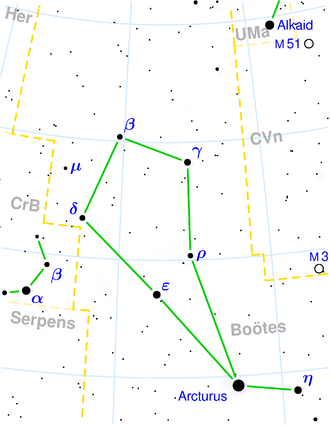NGC 5610
| Galaxy NGC 5610 |
|
|---|---|

|
|
| SDSS recording | |
| AladinLite | |
| Constellation | Bear keeper |
|
Position equinox : J2000.0 , epoch : J2000.0 |
|
| Right ascension | 14 h 24 m 22.9 s |
| declination | + 24 ° 36 ′ 51 ″ |
| Appearance | |
| Morphological type | SB (s) from / Sy |
| Brightness (visual) | 13.5 likes |
| Brightness (B-band) | 14.3 mag |
| Angular expansion | 2.0 ′ × 0.7 ′ |
| Position angle | 108 ° |
| Surface brightness | 13.7 mag / arcmin² |
| Physical data | |
| Affiliation | LGG 381 |
| Redshift | 0.016888 +/- 0.000073 |
| Radial velocity | (5063 +/- 22) km / s |
|
Stroke distance v rad / H 0 |
(229 ± 16) x 10 6 ly (70.1 ± 4.9) Mpc |
| history | |
| discovery | Wilhelm Herschel |
| Discovery date | May 19, 1784 |
| Catalog names | |
| NGC 5610 • UGC 9230 • PGC 51450 • CGCG 133-049 • MCG + 04-34-025 • IRAS 14221 + 2450 • 2MASX J14242294 + 2436513 • GC 3877 • H III 136 • h 1802 • LDCE 1053 NED004 | |
NGC 5610 is a barred spiral galaxy with an active galactic nucleus from Hubble type SBab in the constellation Bootes the northern sky . It is an estimated 229 million light years from the Milky Way and about 135,000 light years in diameter.
The galaxies IC 1006 , IC 4418 , IC 4420 are located in the same area of the sky .
The object was discovered on May 19, 1784 by Wilhelm Herschel with an 18.7-inch reflector telescope, who marked it with “vF, S, E, nearly par. with 240 like two stel “.
NGC 5610 group ( LGG 381 )
| Galaxy | Alternative name | Distance / million Lj |
|---|---|---|
| NGC 5610 | PGC 51450 | 177 |
| NGC 5548 | PGC 51074 | 229 |
| NGC 5559 | PGC 51450 | 233 |
| PGC 51121 | UGC 9165 | 237 |
